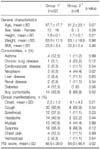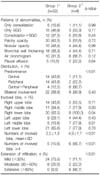Abstract
Background
The aim of the present study was to evaluate whether findings on initial chest computed tomography (CT) of influenza pneumonia can help predict clinical outcome.
Methods
We reviewed all adult patients admitted to the Emergency Department (ED) with a confirmed diagnosis of novel influenza A H1N1 virus (2009 H1N1) pneumonia, who underwent chest CT upon admission between Aug 26, 2009 and Jan 31, 2010. Radiologic findings were characterized by type and pattern of opacities and zonal distribution. Clinical outcome measures were intensive care unit (ICU) admission, mechanical ventilation, and inhospital death.
Results
Of 59 patients diagnosed with 2009 H1N1 pneumonia, 41 (69.5%) underwent chest CT on admission into ED. Nine (22%) of these patients developed adverse clinical outcomes requiring the following treatments: 9 (22.0%) ICU admissions, 5 (12.2%) mechanical ventilation, and 3 (7.3%) inhospital deaths. Counting the number of patients with more than 4 involved lobes, the sensitivity, specificity, positive predictive value, and negative predictive value for detection of adverse clinical outcome were 67%, 84%, 55% and 80%, respectively.
Figures and Tables
References
1. Perez-Padilla R, de la Rosa-Zamboni D, Ponce de Leon S, Hernandez M, Quiñones-Falconi F, Bautista E, et al. Pneumonia and respiratory failure from swine-origin influenza A (H1N1) in Mexico. N Engl J Med. 2009. 361:680–689.
2. Choi WJ, Kim WY, Kim SH, Oh BJ, Kim W, Lim KS, et al. Clinical characteristics of pneumonia in hospitalized patients with novel influenza A (H1N1) in Korea. Scand J Infect Dis. 2010. 42:311–314.
3. de Roux A, Marcos MA, Garcia E, Mensa J, Ewig S, Lode H, et al. Viral community-acquired pneumonia in nonimmunocompromised adults. Chest. 2004. 125:1343–1351.
4. Jennings LC, Anderson TP, Beynon KA, Chua A, Laing RT, Werno AM, et al. Incidence and characteristics of viral community-acquired pneumonia in adults. Thorax. 2008. 63:42–48.
5. Choi SS, Kim WY, Kim SH, Hong SB, Lim CM, Koh Y, et al. Associated factor related to major complications of patients with hospitalized for 2009 H1N1 influenza pneumonia. Tuberc Respir Dis. 2010. 68:162–167.
6. CDC protocol of realtime RTPCR for influenza A (H1N1) [Internet]. World Health Organiztion. 2009. updated 2009 Oct 6; cited 2010 May 20. Geneva: World Health Organization;Available from: http://www.who.int/csr/resources/publications/swineflu/realtimeptpcr/en/index.html.
7. Mandell LA, Wunderink RG, Anzueto A, Bartlett JG, Campbell GD, Dean NC, et al. Infectious Diseases Society of America/American Thoracic Society consensus guidelines on the management of community-acquired pneumonia in adults. Clin Infect Dis. 2007. 44:Suppl 2. S27–S72.
8. Agarwal PP, Cinti S, Kazerooni EA. Chest radiographic and CT findings in novel swine-origin influenza A (H1N1) virus (S-OIV) infection. AJR Am J Roentgenol. 2009. 193:1488–1493.
9. Bay A, Etlik O, Oner AF, Unal O, Arslan H, Bora A. Radiological and clinical course of pneumonia in patients with avian influenza H5N1. Eur J Radiol. 2007. 61:245–250.




 PDF
PDF ePub
ePub Citation
Citation Print
Print






 XML Download
XML Download